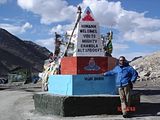http://www.youtube.com/watch?v=vNoh4oLstCU
Watch the Riders ride on sand and gravel . Its interesting to see how the rider is able to balance the bike in the sand.
Follow the link and you know how.
http://www.flamesonmytank.co.za/offRoad.htm
Skill 2. Need for Speed.
This is difficult as the natural reaction is to travel too slowly. The track ahead will be covered in loose stones and sand. All you want to do is shut off the gas! Don't do it!! Slow down a little and then just before the loose stuff starts accelerating gently. If the bike twitches and moves around . . . gas it a little more! Once you are through the bad patch you can slow down a little if you want to.
The amount of stability a motorcycle has depends on its forward motion. More speed helps it punch through and over the bad surface. Generally as the bike travels faster and faster you will find that it becomes more balanced, stable and maneuverable. Going too slowly over rough terrain will cause the bike to move around more and perhaps cause you to panic. Within reason therefore go a bit faster than you are comfortable with. Here as some suggestions . . .
• 10 - 40 kph for a trail or path not suitable for ordinary cars
• 40 - 60 kph for a road in poor condition (narrow, with ruts, bends, potholes and loose stones)
• 60 - 80 kph for a typical dirt road (reasonably straight, offering a good line with reasonable traction)
• 80 - 100 kph for a good dirt road (straight, offering a good line with good traction. The verges should be clear of trees and bush because at this speed you do not want an animal to step out in front of you)
Because you need to keep the throttle open when travelling through the loose stuff do not approach bad patches too fast or in a gear that leaves you in the middle of the power band. Choose a lower gear at the bottom end of the power band so that you can accelerate gently!
